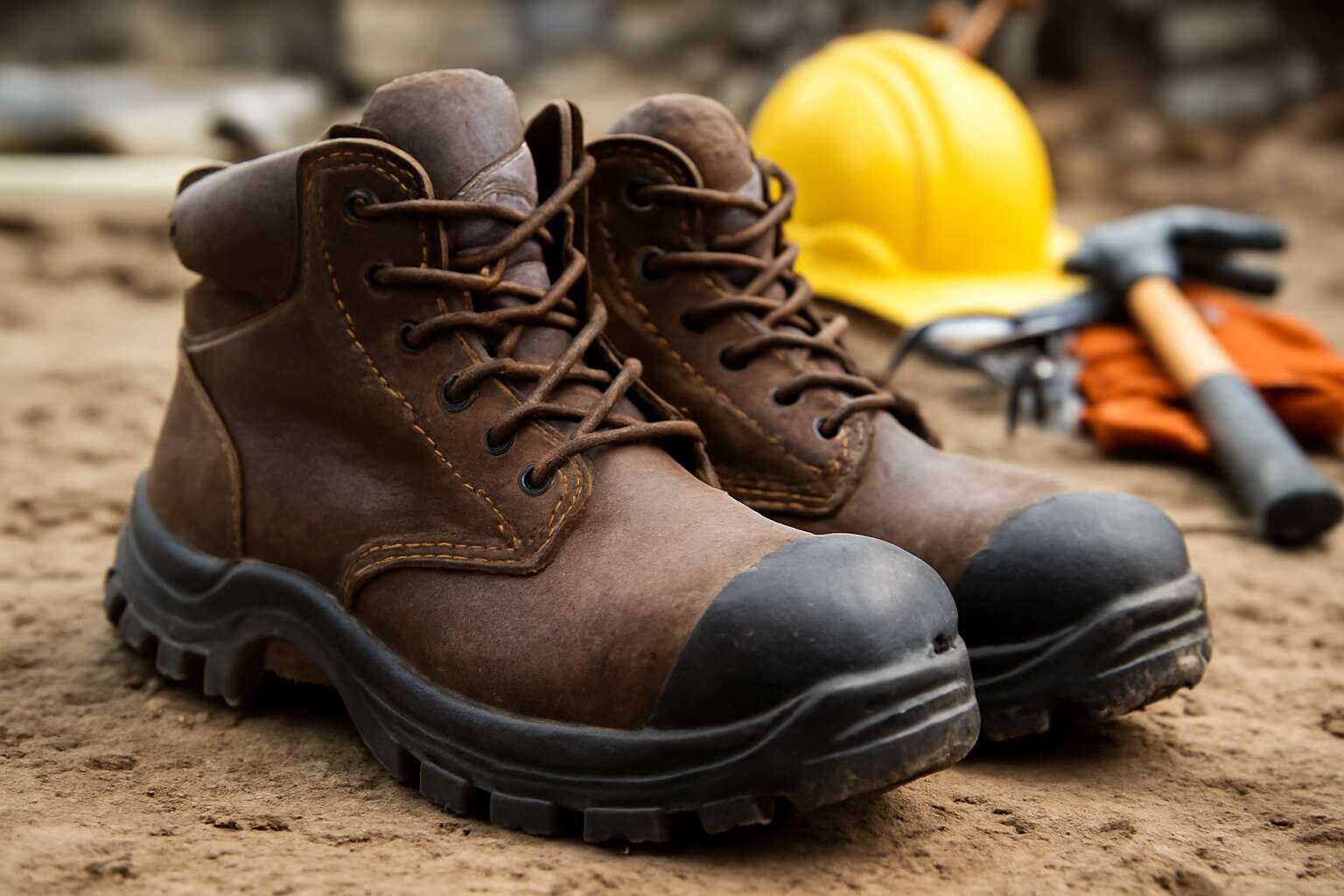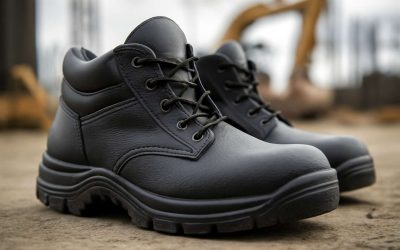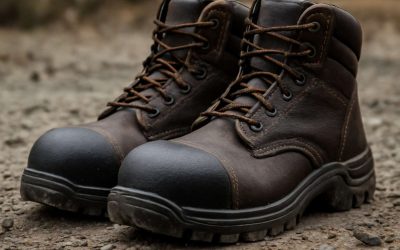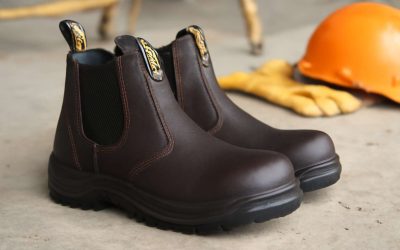Understanding Safety Boots
Types of Safety Boots – Different varieties available for various industries
When it comes to safeguarding your toes and your dignity, understanding what are safety boots is paramount. These sturdy foot protectors aren’t just fashion statements for hardened workers—they’re essential armor tailored to combat the chaos of industrial environments. But did you know there are different varieties of safety boots designed to meet the demands of various industries? From steel-toe options for construction sites to slip-resistant soles for warehouse warriors, each type serves a specific purpose. Knowing the distinctions can make all the difference between a minor mishap and a trip to the emergency room.
For those working in rugged terrains or hazardous conditions, choosing the right safety boots involves considering factors like puncture resistance, waterproof capabilities, and insulation. Here’s a quick rundown of popular types:
- Steel-toe safety boots – classic protection for heavy-duty tasks.
- Composite safety boots – lightweight yet durable, perfect for prolonged wear.
- Electrical hazard boots – designed to insulate against electrical shocks.
- Waterproof safety boots – ideal for outdoor jobs or wet environments.
Understanding what are safety boots and their various types ensures workers stay safe, comfortable, and ready to take on whatever the job throws their way—without sacrificing style or safety! After all, a good pair of safety boots is an investment in both longevity and peace of mind.
Key Features of Safety Boots – Design elements and protective qualities
Understanding what are safety boots is the first step toward ensuring maximum protection on the job. These boots aren’t just footwear—they’re a critical barrier against workplace hazards. Key design elements include reinforced toe caps, slip-resistant soles, and durable materials that withstand tough conditions. Each feature plays a vital role in safeguarding your feet from injury and providing comfort during long shifts.
Protective qualities vary depending on the type of safety boots chosen. For example, steel-toe boots offer robust impact resistance, while waterproof safety boots keep feet dry in wet environments. Insulation adds warmth in cold climates, and specialized soles prevent slips on oily or uneven surfaces.
- Impact resistance
- Slip resistance
- Puncture protection
When selecting safety boots, it’s essential to consider the specific hazards of your work environment. Proper design elements can mean the difference between safety and injury, making it clear why understanding what are safety boots is so important for every worker. They are an investment in safety, comfort, and peace of mind—especially in demanding industries across South Africa.
Materials Used in Safety Boots – Common materials and their benefits
Understanding the materials used in safety boots is essential for anyone seeking the right footwear to navigate South Africa’s diverse work environments. These boots aren’t just about protection—they’re about durability and comfort, forged from materials that withstand the harshest conditions. Steel, for example, remains a popular choice for toe caps, offering unparalleled impact resistance, while rubber soles deliver exceptional slip resistance on oily or uneven surfaces.
Natural leather, known for its breathability and resilience, is a classic material that adapts beautifully to long shifts, especially in industries where comfort is paramount. Synthetic fabrics and composites are increasingly common, providing lightweight alternatives without sacrificing strength. For cold climates or chilly warehouse environments, insulation materials are integrated seamlessly to ensure warmth without compromising flexibility.
To paint a clearer picture, here’s a quick overview of common materials and their benefits:
- Leather: Durable, breathable, and comfortable for extended wear.
- Rubber: Excellent for slip resistance and waterproofing.
- Steel or composite toe caps: Impact-resistant, offering vital protection against falling objects.
- Insulation layers: Keep feet warm in cold conditions without adding bulk.
Knowing what are safety boots made of allows workers and employers alike to choose footwear that not only guards against workplace hazards but also adapts to the specific demands of South Africa’s varied industries. After all, safety is an investment—crafted from the right materials, it becomes an unyielding shield against unforeseen dangers.
Purpose and Benefits of Safety Boots
Protecting Against Workplace Hazards – Impact, compression, chemicals, and electrical hazards
In the realm of industrial toil, where the very ground seems to whisper threats, understanding what are safety boots is paramount. These steadfast guardians are crafted to shield workers from a multitude of workplace hazards, transforming peril into a manageable challenge. When faced with impact and compression risks, safety boots serve as a resilient barrier, safeguarding toes and feet from crushing blows or falling objects that could otherwise shatter lives in an instant.
But their protective embrace doesn’t stop there. Safety boots also act as a formidable defense against chemical splashes and electrical hazards, which lurk invisibly in certain environments. The importance of these sturdy footwear extends beyond mere comfort—they are a crucial line of defense, reducing injury severity and even saving lives.
Select safety boots with features like reinforced toes, slip-resistant soles, and chemical-resistant materials, which are vital for active workplaces. Truly, understanding what are safety boots reveals a world where safety and durability unite to forge an unyielding shield for every worker brave enough to face the industrial unknown.
Enhancing Workplace Safety – How safety boots reduce injury risk
In the relentless landscape of South Africa’s industrial sectors, safety isn’t just a priority—it’s a necessity. Understanding what are safety boots is key to grasping how they serve as vital guardians in hazardous environments. These rugged footwear options are designed with purpose, aiming to drastically reduce the risk of injury and enhance overall workplace safety.
By providing a formidable barrier against impact, compression, and chemical exposure, safety boots help prevent severe injuries that could otherwise be life-altering. They serve as the first line of defense, especially when the environment teems with unpredictable dangers. For workers navigating complex terrains or handling volatile substances, the right safety boots are an unwavering shield.
- Reduced injury severity
- Enhanced grip and slip resistance
- Protection against electrical hazards
When workers wear safety boots tailored to their specific needs, they gain peace of mind and a higher level of confidence. It’s more than just footwear—it’s a powerful testament to a company’s commitment to protecting its workforce. Truly, knowing what are safety boots unlocks a new understanding of how safety and durability merge to forge resilience in the face of industrial adversity.
Comfort and Support – Importance of ergonomics and fit
In the bustling corridors of South Africa’s industrial landscape, the phrase “what are safety boots” often echoes in safety briefings and worker’s chatter. Yet, beyond the mere definition, lies a nuanced appreciation for their ergonomic design and the profound impact they have on daily safety. Comfort and support are not mere luxuries but essential elements, ensuring that workers can perform their duties without the distraction of discomfort or the risk of strain.
When safety boots fit impeccably, they become more than just protective gear—they transform into a trusted companion in hazardous environments. Properly designed safety boots distribute pressure evenly, reducing fatigue and preventing injuries related to prolonged standing or strenuous activity. This focus on ergonomics enhances overall productivity and morale, proving that safety isn’t just about protection but also about promoting well-being.
For those seeking footwear that marries durability with comfort, selecting the right safety boots is paramount. It’s a subtle art—striking the perfect balance between safeguarding your feet and ensuring they’re supported throughout a demanding shift. After all, understanding what are safety boots is the first step toward appreciating their role as an indispensable asset on the factory floor or construction site.
Standards and Certifications for Safety Boots
International Safety Standards – EN ISO, ASTM, and other relevant standards
When it comes to understanding what are safety boots, one thing remains clear: not all safety footwear is created equal. In fact, the backbone of reliable safety boots lies in their adherence to strict international standards and certifications. Without these, you might as well be walking on stilts made of cardboard!
Global safety standards like EN ISO (European Norms), ASTM (American Society for Testing and Materials), and others serve as the gold standard — ensuring that safety boots meet rigorous criteria for protection, durability, and performance. These certifications aren’t just bureaucratic hoops; they are vital benchmarks that keep workers safe from impact, compression, electrical hazards, and chemical spills.
- EN ISO 20345: The European standard for safety footwear, covering impact resistance, slip resistance, and toe protection.
- ASTM F2413: The American benchmark, emphasizing electrical hazard protection and puncture resistance.
- CE marking: A testament that safety boots meet EU safety, health, and environmental requirements.
Choosing safety boots that meet these standards isn’t just about compliance—it’s about peace of mind and ensuring that your feet are protected in the toughest environments. Because, let’s face it, when you’re navigating hazardous workplaces, standards aren’t just paperwork—they’re a lifeline.
What Certifications Guarantee – Compliance and safety assurance
When it comes to understanding what are safety boots, one thing is crystal clear: not all footwear claiming safety is created equal. Certifications serve as the invisible handshake between manufacturers and workers, promising that the boots in question truly meet rigorous safety standards. In South Africa, where industrial accidents still cast a long shadow, these certifications are more than mere paperwork—they’re a lifeline.
Guaranteeing compliance with established safety standards, certifications like EN ISO 20345 and ASTM F2413 are vital. They verify that safety boots have undergone rigorous testing for impact resistance, electrical hazard protection, and puncture resistance. Additionally, the CE marking, recognized across Europe, assures that the footwear meets strict EU safety, health, and environmental requirements.
- Impact resistance
- Electrical hazard protection
- Puncture resistance
These elements collectively provide peace of mind—knowing your safety boots are more than just stylish; they are a shield in hazardous environments.
How to Verify a Safety Boot’s Certification – Tips for consumers
Understanding what are safety boots is essential for anyone stepping into hazardous work environments. But beyond their rugged appearance lies a complex world of certification and standards that guarantee their protective prowess. For South African workers navigating industries fraught with risks, verifying the authenticity of safety boots is not just prudent—it’s vital. Certifications act as a beacon of trust, illuminating whether a pair truly meets the demanding safety benchmarks required in perilous settings.
To ensure a safety boot’s certification is genuine, consumers should look for specific marks and labels. These certifications, such as EN ISO 20345 or ASTM F2413, are the gold standards that confirm the footwear has passed rigorous impact resistance, electrical hazard protection, and puncture resistance tests.
- Check for official certification labels embossed or stitched onto the boots.
- Verify the certification number with the issuing authority or through their official website.
This process transforms the task from mere shopping to a safeguard against compromised safety. When you understand what are safety boots and how to authenticate their certification, you arm yourself with the knowledge to choose footwear that truly shields in the face of workplace hazards.
Choosing the Right Safety Boots
Factors to Consider – Job requirements, environment, and comfort
Understanding what are safety boots is only the beginning; choosing the right pair requires a nuanced consideration of several critical factors. In South Africa’s diverse work environments, where hazards vary from rugged construction sites to chemical labs, it’s essential to tailor your safety footwear to specific job requirements. The importance of environment cannot be overstated—whether you need waterproof safety boots for rainy conditions or insulated ones for colder climates, the right choice can dramatically reduce risks.
Comfort and fit should never be overlooked, as prolonged wear demands ergonomic design that supports the foot’s natural biomechanics. To navigate this complex landscape, consider a few key elements: the level of impact protection, slip resistance, and chemical resistance. These features, among others, directly influence how effectively safety boots safeguard the wearer. Remember, investing in quality safety boots is an investment in both safety and productivity—because, at the end of the day, knowing what are safety boots truly means understanding how they serve your specific needs.
Features to Look For – Slip resistance, waterproofing, insulation
When it comes to safeguarding your toes and your peace of mind, understanding what are safety boots is only half the battle won. The real challenge lies in choosing a pair that ticks all the right boxes—especially when South Africa’s climate and work sites can be as unpredictable as a lion on the prowl. Features like slip resistance and waterproofing are non-negotiable for those working in wet or oily environments, where a single slip-up might turn a routine day into a trip to the emergency room.
Imagine the impact of a slick, muddy construction site—your safety boots should grip like a mountain goat on a cliff. Waterproofing keeps your feet dry through torrential rains, while insulation provides warmth in chilly conditions, making your boots your best ally against nature’s unkind weather. The secret is to look for boots with soles designed to prevent slips and chemical-resistant coatings that shield your feet from hazardous substances. Whether you’re navigating oily floors or icy pavements, choosing safety boots with these features can mean the difference between a safe day’s work and a costly mishap.
Sizing and Fit – Ensuring proper fit for maximum protection
Choosing the right safety boots is a vital step toward safeguarding your feet on demanding South African work sites. The perfect fit isn’t just about comfort—it’s about ensuring maximum protection, stability, and durability. When asking yourself what are safety boots, remember that proper sizing and fit are the cornerstone of effective workplace safety. Ill-fitting boots can cause blisters, reduce mobility, and even compromise your safety if they shift or pinch during crucial moments.
To find the ideal pair, focus on a few key factors. First, measure your feet accurately, taking into account both length and width, as many safety boots come in various sizes and widths. It’s wise to try on boots at the end of the day when your feet are naturally larger. Remember, a snug but not tight fit provides the best combination of support and comfort. Look for boots that offer ample room in the toe box to prevent cramping, especially if you are required to wear them all day long.
In addition, consider the overall support—arched insoles, cushioned midsoles, and ankle stability—especially for those navigating uneven terrain or working long shifts. Here’s a quick guide:
- Ensure there’s enough space to wiggle your toes comfortably.
- Check for a secure fit around the heel to prevent slipping.
- Test for flexibility while maintaining ankle support.
Remember, safety boots that fit perfectly not only boost your confidence but also significantly reduce the risk of injury. When you understand what are safety boots and prioritize their fit, you’re investing in more than just footwear—you’re investing in your safety and peace of mind every step of the way.
Maintenance and Care of Safety Boots
Cleaning Tips – Proper cleaning techniques for longevity
When it comes to prolonging the lifespan of your safety boots, proper maintenance and care are paramount. After all, understanding what are safety boots goes beyond their protective features—it’s about preserving their integrity through diligent cleaning. The harsh South African terrain, with its dusty roads and unpredictable weather, demands that safety boots be kept in pristine condition to maintain their protective qualities.
To keep your safety boots performing at their best, establish a routine cleaning regimen. Gently remove mud, dirt, and debris with a soft brush or damp cloth after each use. For stubborn stains, use mild soap and water, avoiding harsh chemicals that could degrade the materials. Regularly inspecting your safety boots for signs of wear or damage ensures you catch issues early, preventing hazardous situations on the job site.
Remember, the longevity of your safety boots depends on proper care.
- Avoid soaking them completely, as excessive moisture can weaken leather and other materials.
- Allow your safety boots to air dry naturally, away from direct heat sources that might cause cracking or warping.
With consistent maintenance, your safety boots will not only look good but continue to provide the essential protection they are designed for, ensuring your safety in the workplace remains uncompromised.
Inspection and Replacement – Identifying wear and when to replace
Understanding what are safety boots extends beyond their initial purpose. It’s crucial to recognize that even the most robust safety footwear requires diligent inspection and timely replacement to ensure continuous protection. Over time, signs of wear and tear can compromise their integrity, turning them from a safeguard into a hazard.
Regularly examining your safety boots for signs of deterioration is essential. Look for cracked or worn soles, frayed stitching, or compromised waterproofing. These indicators suggest that the boots may no longer provide the necessary impact or chemical resistance. In some cases, a simple repair might suffice, but often, replacement becomes inevitable to uphold safety standards.
- Persistent cracking or degradation of the material
- Loss of tread grip, increasing slip risk
- Visible deformities or separation at seams
- Unpleasant odours that don’t dissipate despite cleaning
When these signs are evident, it’s time to consider replacing your safety boots. Ignoring these warning signals can leave workers vulnerable to workplace hazards, especially in demanding environments like South African construction sites or industrial facilities. Remember, the integrity of your safety footwear directly correlates with your safety and well-being on the job. Never underestimate the importance of timely inspection and replacement to maintain optimal protection.
Storage Recommendations – Keeping safety boots in optimal condition
Maintaining the longevity and protective efficacy of your safety boots hinges on proper storage and care. When not in use, store them in a cool, dry place away from direct sunlight and extreme temperatures, which can degrade materials over time. Proper storage prevents unnecessary wear and helps preserve the integrity of key features like waterproofing and slip resistance.
To keep your safety boots in optimal condition, it’s wise to clean them regularly, removing dirt, mud, and chemicals that can erode their protective layers. Use a soft brush and mild soap—harsh chemicals can compromise the materials used in safety boots, especially those designed for demanding environments like South African construction sites.
Here’s an easy step-by-step storage recommendation to ensure your safety boots remain reliable:
- Clean thoroughly after each shift, paying close attention to soles and seams.
- Allow boots to air dry naturally—avoid direct heat sources that can cause cracking or warping.
- Store them upright in a ventilated area to prevent moisture buildup, which can lead to mould and odour.
By following these simple practices, you extend the lifespan of your safety boots and keep their protective qualities intact. Remember, knowing what are safety boots extends beyond their initial purpose—proper care is essential to ensure they continue to shield you from impact, chemicals, and other hazards in your workplace.




0 Comments